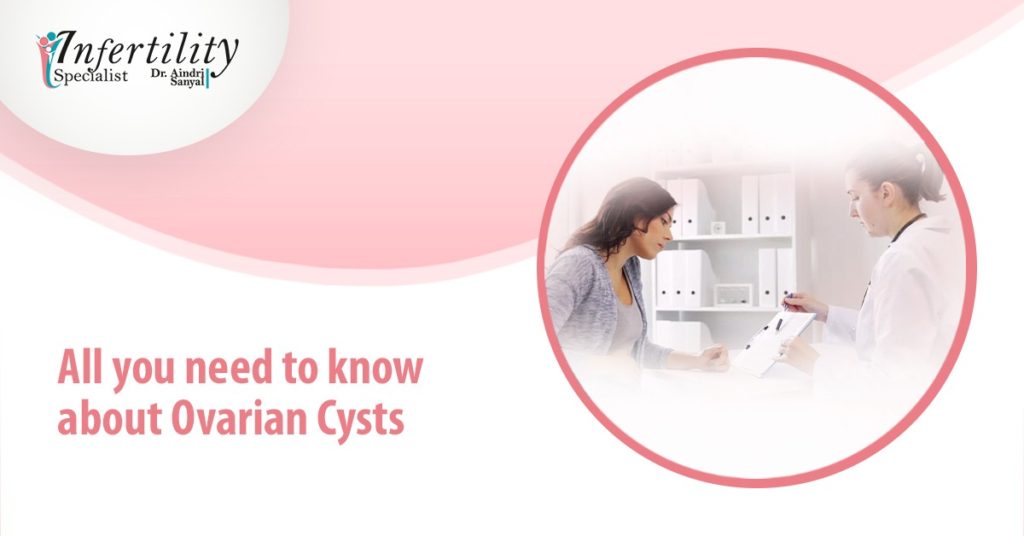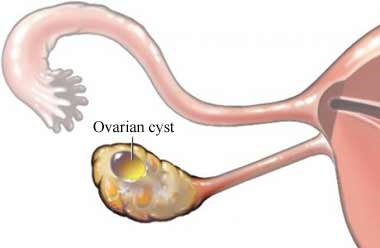
Ovarian cysts are fluid-filled sacs that develop on the ovaries. Most of these cysts are usually harmless and get resolved by themselves. Only when they become large, they tend to cause pain and may turn out to be cancerous.
How do you know if you have a cyst which requires treatment and when should you be consulting a doctor? Also, can a cyst affect fertility and what is the outcome if you have a cyst when pregnant? Here’s an overview of different types of cysts, symptoms and removal in my guide to ovarian cysts.
What is an ovarian cyst?
A cyst is a small pocket or sac that is filled with air, fluid, or a thick/semi-solid substance. Cysts develop anywhere in the body, commonly on the skin. Ovarian cysts are filled with fluid and can grow within the ovary or attached outside.

Types of ovarian cysts
There are two types of ovarian cysts.
Fuctional cysts: This type of cysts are the most common. They form due to normal menstrual cycles. A follicle that has ruptured while ovulating can continue growing either before or after it has released eggs. Functional cysts do not usually last long and tend to be harmless.
Pathological cysts: These form when cells overgrow or multiply and result in tumours. These can either be benign or malignant. Pathological cysts are rarer than the functional type. 95% of pathological cysts are benign or non-cancerous. There are different kinds, including cystadenomas and dermoid cysts.
Dermoid cysts
Also popular as teratomas, dermoid cysts are present at the time of birth. They may be running in families. Not linked to menstrual cycles, they develop from embryonic cells, which can develop into any kind of cells. This indicates that dermoid cysts can contain hair, skin, bone or teeth.
Dermoid cysts can grow up to 15cms in diameter and are common in women under the age of 40 years. They are discovered by chance during an examination or a scan for yet another condition.
Cystadenomas
Cystademonas develop from cells of the outer part of the ovary. These are more common in women over the age of 40 years. There are two types of cystadenomas. The first type is known as a serous cystadenoma. It stays small while the second type called a mucinous cystadenoma can become large up to 30cms in diameter. These two types can twist or rupture.
Endometriosis
Endometriosis is a medical condition in which tissues from the lining of the womb or the endometrium grows at other locations in the body like the fallopian tubes, bowel, or on the ovary. This can form a cyst. Endometriomas are called chocolate cysts because they are filled with old and brown blood.
Polycystic ovaries
Sometimes multiple cysts can develop on an ovary. If over 12 cysts are diagnosed, it is referred to as a polycystic ovary. When multiple cysts develop on the ovaries, it results in a condition called Polycystic Ovary Syndrome or PCOS. Usually, there are visible symptoms due to an unusual balance of sex hormones, including testosterone and oestrogen.
PCOS symptoms include inexplicable weight gain, acne, facial and body hair growth, lack of periods and difficulty conceiving. The cysts are much smaller than pathological or functional cysts and must be treated as a totally separate condition.
Who is at risk of suffering from ovarian cysts?
Any woman can develop ovarian cysts. As functional cysts are linked to menstrual cycles, they are more common in women who have periods. Pathological cysts, including those that are cancerous are more common in women who have undergone menopause.
Cysts often develop during hormonal changes, such as during pregnancy or while consuming progesterone-based contraceptives like contraceptive implant, progesterone-only pill, and so on. They are more common in women who receive hormones as part of hormonal therapy for breast cancer.
Women who suffer from endometriosis or have polycystic ovary syndrome are at an increased risk of ovarian cysts.
Ovarian cyst symptoms
You may not get any symptom from an ovarian cyst if it is a smaller one. When cysts cause symptoms, they affect patients in ways, including the following:
- Pain during sexual intercourse
- Change in bowel habit, including constipation
- Urge to urinate
- Bloating
- Feeling full even when you have not eaten a lot
- A change in periods – heavier, lighter, more painful or less frequent
What happens next?
If you have no symptoms, you may not need any treatment. But if you have symptoms or if the ultrasound shows a complex or large cyst, you will be referred to a specialist. In the unlikely event that the tests suggest cancer, you will be referred to a gynaecological cancer specialist.
What can be my treatment options?
Treatment options include ‘waiting and watching’ or an operation to remove cysts if they are getting bigger. Your choice depends on symptoms, appearance and size, and results of any blood test your doctor may have asked you to take. You should be given information about the choices, including information about the benefits and risks of each option.


